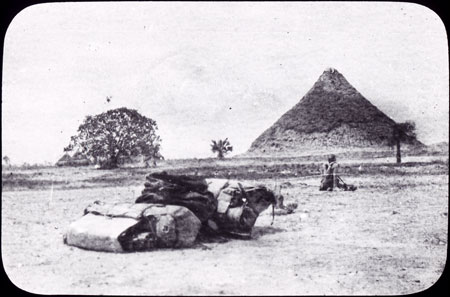Nuer mound of Deng Kur

82 x 82 mm | Lantern slide glass
MountDimension:
82 x 82 mm
Date of Print:
Unknown
Previous Other Number:
V.e.40 (460)
Accession Number:
1967.26.187
Description:
Although not positively identified by Seligman, this seems almost certainly to be a view of the mound built by the Nuer prophet Ngundeng (d.1906) at the end of the nineteenth century, and added to by his son Gwek (d.1928), who also became a prophet.
He describes it in his list as a grave pyramid, possibly since he was informed that Ngundeng was buried within his hut at the base of the mound.
At one time the mound, known as Deng Kur and associated with the Dinka-originating cult of the spirit Deng, was furnished by elephant tusks around its 300-foot circumference, standing over 50 feet high.
Made from the baked earth, ashes and dung of old cattle camp floor layers, it became an important political symbol of Nuer resistence to colonial rule, and was eventually bombed by the administration in 1928.
The Seligmans seem not to have visited Nuer country (the heavy bagagge in the foreground is also incongruous with their light trekking), and so this is almost certainly a copy of a print, possibly by E.S.
Crispin, who visited and photographed the pyramid as part of the Sudd cutting expedition along the White Nile during 1901-1902.
Photographer:
?Edward Smyth Crispin
Date of Photo:
1901 - 1902
Region:
[Southern Sudan] Jonglei Rumjok country
Group:
Nuer Lou Rumjok
PRM Source:
London School of Economics and Political Science
Acquired:
Donated 1967
Other Owners:
C. G. Seligman slide collection
Class:
Ritual , Religion
Keyword:
Shrine
Documentation:
Manual Catalogue in Related Documents File. See Biog PRM for brief info on E. S. Crispin
Primary Documentation:
Accession Book Entry - [1967.26] THE LONDON SCHOOL OF ECONOMICS AND POLITICAL SCIENCE, HOUGHTON STREET, ALDWYCH, LONDON, W.C.E.
PER MR ANTHONY FORGE - SUDAN.
Box containing 309 lantern slides (3 1/4” x 3 1/4”) made from photographs taken by the late Professor C.
G.
SELIGMAN in various parts of the SUDAN.
All slides numbered and labelled.
Catalogue in file (“Seligman Slide Collection”).
Additional Accession Book Entry - [in pencil] 18 Parks Rd.
Manual catalogue entry (thermofax catalogue copy in folder '27-06 Seligman Slide Collection') - "V.e.40. Nuer grave pyramid. (460)" Additional ms note (1967) - "slightly scratched"
Note on lantern slide ms ink - "V.e.40. Nuer grave pyramid. CGS. 460."
Manual catalogue entry (thermofax catalogue copy in folder '27-06 Seligman Slide Collection') - "V.e.40. Nuer grave pyramid. (460)" Additional ms note (1967) - "slightly scratched"
Note on lantern slide ms ink - "V.e.40. Nuer grave pyramid. CGS. 460."
Other Information:
Ethnographic context - The Seligmans discuss Ngundeng's pyramid on pages 231-232 of Pagan Tribes of the Nilotic Sudan (London, Routledge 1932), but no comment is made about having visited it.
Indeed their comment that 'more than twenty years ago [i.e.
their 1909-10 visit] we were told that Ngundeng was buried within his hut at the base of the pyramid' suggests that they did not visit Rumjok country, a fact corroborated by their diary entries.
From the appearance of the earth on the pyramid, it resembles the state in which it appears in other 1901 photographs by Dr E.S.
Crispin published as Plates XXI Fig.1 & 2 (facing page 232) of C.G.
& B.
Seligman's Pagan Tribes of the Nilotic Sudan (London, Routledge 1932).
The possibility remains that this is a copy of another of Dr Crispin's photographs of the mound from 1901, when he was engaged in the Sudd cutting expedition along the White Nile.
Further research may shed more light on this image.
[Chris Morton 18/10/2004] Dr Edward Smyth Crispin, graduated as a doctor in 1898 and volunteered as a civil surgeon in South Africa during the Boer War.
When his contract ended, he accepted the offer of the Principle Medical Officer of the Egyptian Army.
He arrived in Cairo in February 1890.
In 1902, he was sent to Southern Sudan to deal with health problems in that area.
[Chris Morton 18/10/2004]
Recorder:
Christopher Morton [18/10/2004] [Southern Sudan Project]

